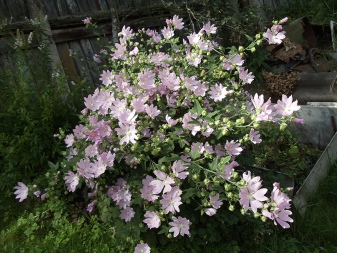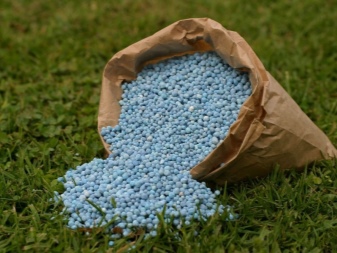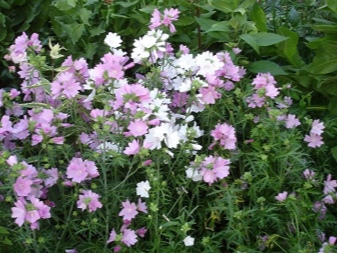Musk mallow: description, planting and care

Musk mallow compares favorably with its "relatives" by the presence of not only a delicate color, but also a fragrant smell. Miniature shrubs grow only up to one meter, but they continue to bloom almost until the onset of frost.






Peculiarities
Musk mallow is a herbaceous plant, reaching a height of 20 to 100 centimeters. The variety got its name due to the unusual but pleasant musky aroma inherent in this perennial culture. The straight, but branching stems are covered with small hairs, like the leaves, on the underside of which white growth appears. The leaf plates of the plant, another name for which sounds like mallow, are rounded and sit on long petioles. Flowers, as a rule, are solitary, although sometimes they grow in a combination of three, and at the top they gather in inflorescences.



The calyx of three lobes is covered with hairs, and the corolla, the size of which is a couple of times larger, has a pale pink or snow-white color. The diameter of one flower reaches 5 centimeters. The fruit of the musk mallow also looks unusual, representing 15–20 particles collected around the central cone. Musk mallow is not only a popular garden plant, but also provides bees with a large amount of nectar. Man uses the medicinal properties of this culture. For example, a decoction of the root helps with diseases of the stomach and intestines, tea from the fruits strengthens the immune system, and baths from infused leaves heal wounds.
In some countries, the stems, roots, leaves and fruits of mallow are even eaten.


How to plant?
Planting musk mallow in open ground must be carried out in the presence of light and loose soil with a nutritious composition. Excessive moisture negatively affects the condition of the plant, therefore, one should not forget about the drainage layer, and also exclude areas with a close location of groundwater. Better to give preference to a well-lit area and loamy soil rich in humus. Musk mallow will only develop better if it is next to the fence or wall of the house, that is, an obstacle to drafts. Poor soil is pre-enriched with humus.


Planting seeds can be carried out simply by laying them out on the surface of the earth in 2-3 pieces without digging holes, but with further sprinkling with a thin layer of soil. Between individual plantings, at least 30-50 centimeters should be kept so that the grown shrubs do not interfere with each other. Seedlings in this case can be expected in 2-3 weeks, subject to regular irrigation. If it is decided to use the seed in the fall, then you will have to pull out three-centimeter holes, place 5 seeds each already there. The plantings are sprinkled with a loose soil mixture mixed with peat, and must be protected from the winter cold with the help of dry fallen leaves, hay, and spruce branches.
Important! Mature plants do not tolerate transplanting very well. The reason is that by that time the plant has already formed a very long root, which can be damaged when excavated. The same applies to picking, so it is better to plant seedlings immediately in separate containers.


How to take care of it properly?
Caring for musk mallow is considered very simple. The main part of it is irrigation and some top dressing. In a calm summer season, it is enough to water the bush once a week, but when hot days come, it is recommended to increase the frequency of the procedure in accordance with the condition of the soil. It is recommended to complete every fourth watering by gently loosening the soil in the root zone for better oxygen supply.


The main fertilizers required by mallow are complexes containing potassium, nitrogen and phosphorus. The additive is applied in small amounts, usually once every three weeks during the flowering and budding period. Top dressing is carried out during watering. Once a year, the land where the musk mallow grows is enriched with compost or humus, and about 3 kilograms of the substance are consumed per square meter. We must not forget that tall specimens are best fixed on a support in order to avoid stem breakage due to strong winds... As soon as the bud completes its flowering, it is immediately removed, and the wilted branch is cut off so that 30 centimeters of the shoot remain. Before the winter frosts, the mallow is either cut to the root, or insulated with dried foliage and straw.
Important! After the end of flowering, the shoots should still be cut off almost completely, stopping at the surface of the soil. At the same time, the surface is abundantly mulched with compost or humus. From 3 to 4 kilograms of the substance should go per square meter.


Reproduction methods
Perennial mallow, to which musk mallow belongs, is usually propagated either by seeds or seedlings.... The seeds are usually planted outdoors in May or June. In this case, in the first year, you can only expect the appearance of a leaf rosette, but the next year beautiful flowers will appear. Seeds can also be planted first in the greenhouse somewhere from late April to early May, when the threat of frost has finally passed. The grown seedlings are transferred to open ground in the last week of summer.
In any case, the soil must necessarily warm up to at least 10 degrees Celsius.

Seeds for seedlings are planted in flower soil at the junction of winter and spring. Be sure to tighten the container with cling film and do not forget about regular moistening of the earth. The temperature should remain between 20 and 25 degrees Celsius. In addition, additional illumination will most likely be required, since it is important to maintain daylight hours for at least 10 to 12 hours. The film is removed when shoots appear, and after a couple of leaves appear, the specimens are seated in separate containers. A couple of weeks before transplanting into open ground, the seedlings are "hardened" by exposing them to the balcony or already in the garden for a couple of minutes. The main transplant is carried out in late May - early June.
The seed capsule forms after the mallow has faded. However, it cannot be cut off immediately - the seeds must ripen, which will take almost a month. The fact that the time has come to collect the seed will be indicated by the changed color of the box - it will turn yellow, and the box itself will begin to open. Flower seeds should be immediately sent to dry at a temperature of 10 to 12 degrees Celsius, which will last about 10 days. Then they have to be stored in a well-heated, but dry room. Under such conditions, mallow seeds can be stored for almost several years.



When using the cuttings method, the cut shoot should be between 9 and 12 centimeters long. If the planting is carried out in the spring, then it is cut off near the root zone, and if in the fall - closer to the top. The wounds must be treated with wood ash or a special agent to provide protection against infections and diseases. The resulting stalk is planted in a container with a fertile and loose soil mixture, after which it is covered with a plastic bottle or glass jar.Having thus ensured the effect of a greenhouse and not forgetting about regular irrigation, after a short time, you can expect rooting and the emergence of young shoots.

Diseases and pests
Despite good innate immunity against most common diseases, musk mallow can still become infected due to improper care. Excessive irrigation of the soil or heavy rainfall leads to the appearance of spotting and powdery mildew, and the location in the immediate vicinity of metal objects causes the development of rust. The plant suffers from mosaic virus or stem cancer just as often. In all these cases, the first step is to remove the damaged parts of the shrub, and then it is treated with a suitable agent, for example, a fungicide or colloidal sulfur in solution. In the case of rust, the flower can also be treated with a Bordeaux mixture of one or two percent diluted in water, after removing the damaged leaves.


Of insects, the culture is most often attacked by aphids, slugs and spider mites. The slugs will first need to be caught using traps in the form of flat bowls filled with beer. In other cases, insecticides will perfectly cope with the problem.


Use in landscape design
Musk mallow is very often used in landscape design. In addition, when decorating a country-style site, you simply cannot do without it. A compact shrub is found in flower beds, and just on the lawn, and in complex compositions, and on curbs. The combination of mallow and delphinium is considered to be an exquisite looking one.
When forming a flower bed with musk mallow, it is important to remember that the decorative element should create a harmonious picture both in terms of the height of the components, and in their color, and in the shape of individual inflorescences.


In this case, it is necessary to combine mallow with creeping crops and flowering shrubs. For example, dahlias, sage, marigolds, ageratum and nolana will perfectly fit as "neighbors". Judging by the reviews, such a flower bed will bloom throughout the season. A composition composed only of mallows of different varieties and colors is considered no less spectacular. When decorating a site, it is worth planting this culture near fences, walls of houses and gazebos, as well as delimiters of individual zones.


For more information about musk mallow, see the next video.







































































































The comment was sent successfully.